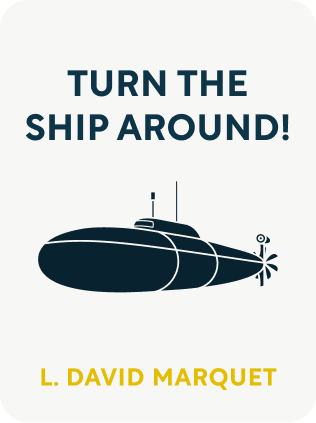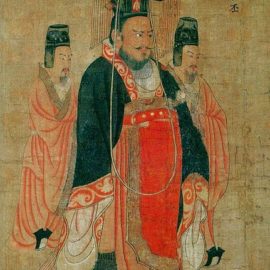

This article is an excerpt from the Shortform book guide to "Turn the Ship Around" by L. David Marquet. Shortform has the world's best summaries and analyses of books you should be reading.
Like this article? Sign up for a free trial here .
How can you get more out of your team by decentralizing authority? How is this different from a traditional leadership structure?
When David Marquet took command of USS Santa Fe in 1999, he revolutionized the way the crew was led. He decentralized authority, which is the key to a leader-leader model. This switch from a traditional leadership structure had amazing results.
Read more to learn how decentralizing authority can make a positive difference for an organization.
Goal: Decentralize Authority
When he assumed command, Marquet’s goal was to create a leader-leader structure by pushing control—the authority to decide what to do and how—downward to the officers and crew.
Over time, Marquet and his officers came up with 20 “mechanisms” (Navy terminology for methods practices) to transform Santa Fe from a leader-follower to a leader-leader organization. The mechanisms focused on three key areas:
- Control: Decentralize authority to increase the crew’s initiative and motivation.
- Competence: Increase the crew’s technical competence and knowledge to make good decisions.
- Clarity: Ensure crew members are clear on the organization’s goals so their decisions align with what Santa Fe needed to accomplish.
The initial focus was on decentralizing authority.
Mechanisms for Decentralizing Authority
The typical leader-follower structure is designed to push information up the chain of command to the people who make the decisions. In contrast, Marquet pushed control down to where the information originated.
Besides pushing authority downward to the chiefs, here are the other mechanisms or methods Marquet used to spread control throughout the organization:
- Identify practices and procedures embedded in the organization—the “genetic code”—that dictate control and rewrite them.
- Get people to act differently and they’ll begin thinking differently (starting with the “three-name rule.”).
- Have supervisors do brief check-ins to ensure crew members are on the right track so time isn’t wasted.
- Have everyone start conversations with the phrase “I intend to…” instead of asking for permission to do something.
- As supervisors, resist the impulse to jump in with solutions when problems occur. Instead, let crew members decide what to do.
- Eliminate top-down systems for monitoring work. Instead, let crew members take ownership of the work and report their progress.
- Get people to “think out loud” about what they intend to do to clarify the rationale for decisions.
- Welcome inspectors as experts who can help the organization improve.
Do the Chiefs Really Run the Navy?
On January 8, 1999, the crew was 172 days to deployment. Although there was an axiom that “the chiefs run the Navy,” they lacked true authority. A top-down leader-follower system was heavily embedded in the Navy and particularly in the submarine force. It started with the Navy’s emphasis on the total accountability of the ship’s commanding officer, which meant that not much happened without getting the CO’s permission.
With followers heavily dependent on the leader, a submarine’s performance hinged on the technical ability and personality of the CO. As a result, performance over time was inconsistent—a ship might do well under one commander, then poorly under the next.
Marquet wanted Santa Fe’s chiefs to go against the grain of the leader-follower tradition and training. Many of them were skeptical, but they agreed that they truly wanted to run the submarine, and they began to talk about what this would mean.
Mechanism: Change the Rules for Control
The chiefs identified an array of problems, including:
- Below-average advancement rates for their teams
- A lengthy qualification program that produced few people qualified to stand watch
- Poor performance evaluations for the ship
- An understaffed watch program which put too much stress on too few people to operate the submarine 24/7
- Lack of authority to control the schedules of their division and men
Instituting a “Chiefs in Charge” program would make the chiefs accountable for the performance of their divisions and crew members. They would need to be involved in their team’s activities and in the operations of the ship. They would spend less time sitting around in the chiefs’ quarters.
For the chiefs to actually run the ship, they needed to be in charge of their own crews, which meant being in charge of crew members’ leave. Instead of the existing 14-step process for approving leave, they decided to make the chief of the boat the final approver for enlisted leave requests. This would eliminate six steps.
A one-word change in the rules put the chiefs in charge of all aspects of managing their crews: watch schedules, qualification schedules, and training school enrollments (because all these things were connected to managing leave). Initially, Marquet worried that the chiefs would automatically approve all requests to curry favor with their crews, but that didn’t happen.
Concerns about decentralizing authority usually fall into two categories: competence and clarity. People worry that those below them won’t make good decisions, either because they lack knowledge or because they don’t understand the organization’s goals. Parts 3 and 4 of this book discuss how to address those concerns.
Changing the rules is a mechanism for decentralizing authority. The first step in delegating decision-making authority is: go a step beyond your comfort zone. On Santa Fe, that step was trusting that the chiefs understood the goals of the operation the way Marquet did, and thus would manage leave requests wisely. Marquet referred to this understanding as having organizational clarity, which is discussed in Part 4. You communicate organizational clarity by talking at every level about what you want to achieve.
Decentralizing authority makes an organization stronger in a way that will last beyond any individual’s tenure. In the book Built to Last, Jim Collins and Jerry Porras write that while leaders come and go, built-in policies and systems endure.
Instead of giving speeches and justifications for change, Marquet and his teams identified the organizational practices and procedures that needed to be changed for the leader-leader method to work beyond his tenure as commander.
The “chiefs in charge” initiatives helped Santa Fe win the award for the best chief’s quarters for the seven consecutive years.
Questions for Leaders
- How can you help your middle managers embrace hands-on work, responsibility, and accountability?
- What embedded policy or rule can you change to give middle managers decision-making authority?
- What are your concerns about delegating control?
- What control do you as the leader need to delegate to reinforce your message and set an example?

———End of Preview———
Like what you just read? Read the rest of the world's best book summary and analysis of L. David Marquet's "Turn the Ship Around" at Shortform .
Here's what you'll find in our full Turn the Ship Around summary :
- How a captain turned the U.S. Navy’s worst-performing nuclear submarine crew into one of the best
- The principles for developing leaders at all levels to create a passionate, high-performing workforce
- Why the "leader-leader" model works better than the "leader-follower" model






